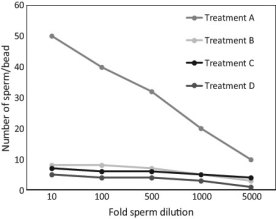Multiple Choice
Use the following information to answer the question.
In order to test how sea urchin sperm bind to eggs, scientists isolated the egg receptor protein that binds to the sperm acrosomal protein called bindin. Plastic beads were coated with egg receptor for bindin (ERB1) from eggs of the sea urchin Strongylocentrotus purpuratus, and then the beads mixed with sperm from S. purpuratus or from the related species, S. franciscanus. The researchers counted how many sperm were bound to each bead. The results are shown in the graph below. (Adapted from Kamei and Glabe 2003)
Treatments:
A: S. purpuratus sperm mixed with S. purpuratus ERB1 beads
B: S. purpuratus sperm mixed with beads containing no ERB1 protein
C: S. franciscanus sperm mixed with S. purpuratus ERB1 beads
D: S. franciscanus sperm mixed with beads containing no ERB1 protein
What is a broader implication from the observations of the experiment?
A) In sea urchins, fertilization of eggs by sperm is dependent upon species-specific protein interactions.
B) Only some species of sea urchins use receptor proteins on their eggs to bind sperm.
C) Protein-coated plastic beads should not be used to test sperm binding to eggs.
D) S. franciscanus is probably not a sea urchin, but must be some other type of organism.
Correct Answer:

Verified
Correct Answer:
Verified
Q24: In a newly fertilized egg, the vitelline
Q25: During frog development, the blastocoel _.<br>A) becomes
Q26: As cleavage continues during frog development, the
Q27: During metamorphosis, a tadpole's tail is reduced
Q28: The term applied to a morphogenetic process
Q31: Among these choices, the largest cell involved
Q32: The nematode Caenorhabditis elegans _.<br>A) is composed
Q33: Use the following information to answer the
Q34: Which of the following is a correct
Q65: Which of the following is an adult